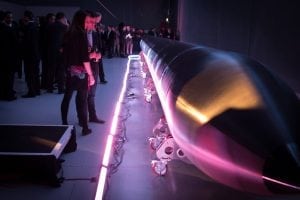Latest News
[Via Satellite 10-23-2014] Rocket Lab, manufacturer of the Electron small satellite launch vehicle, has set its sights on launching no less than once per week when commercial operations begin. The company grabbed headlines after announcing that it had already signed 30 customers for the as-of-yet proven launch vehicle. With a price tag of $5 million or less per launch, Peter Beck, CEO of Rocket Lab, said the company is “frantically” putting together contracts and lining up a manifest they didn’t expect to have so soon.
“There are more in the works everyday. We were totally unprepared for the level of interest in the system. We expected not to have any commitment whatsoever until the vehicle had flown,” Beck told Via Satellite.
Having roughly the same mass as a Ferrari, the Electron rocket is slated to carry 110-kg payloads to a 500-km sun-synchronous orbit from a private launch site in New Zealand. Beck said these parameters were set based off conversations with customers — and, to his credit, they appear quite profitable. Rocket Lab’s goal was to set a price point for a dedicated launch that is roughly equivalent to the cost of a rideshare. And SmallSat owners have shown an enthusiastic response to having the same price with the added benefit of dictating their own orbit.
“We are aiming for our first test flight to be at the end of 2015, and to begin commercial operations in mid 2016. We have a multiple test-flight campaign over that six-month period before we go commercial,” he said.
Beck added that all the 30 customers currently signed are commercial businesses. Though Rocket Lab is talking to potential government customers, the entire manifest to date is for private satellites. Carolyn Belle, an analyst at NSR, said SmallSat operators are typically less risk-averse compared to operators of larger, more expensive spacecraft. This intense backing by commercial operators could be indicative of the pent up demand for low-cost dedicated launches of this nature.
“Considering the near-ubiquitous use of consumer-grade, [Commercial Off the Shelf] COTS materials and low [Technological Readiness Level] TRL instruments as a way to reduce costs and achieve rapid development cycles, it is a logical step for this market to employ an untested launcher with the potential to drive down costs and provide better launch opportunities,” she said. “The SmallSat market is in desperate need for more (and more flexible) launch options, hence the willingness to try an untested vehicle at likely attractive price points.”
Beck said the two goals in mind from the beginning were to address both the cost and frequency of launching with equal concern given to both. Rocket Lab will look to produce no less than one rocket per week to maintain a 52-per year launch pace.
“We build a launch vehicle like you would build a car,” he explained. “When we look at fasteners, or nuts and bolts, we try to standardize on one fastener wherever possible. What that means is on the assembly line you’ve only got one fastener so you can’t mess that assembly up.”
Other considerations included launch sites and reusability. Rocket Lab was originally a New Zealand company, but switched to the United States after raising money from sources such as Silicon Valley venture firm, Khosla Ventures. Electron is now considered a U.S. launch system, and Rocket Lab New Zealand is owned by Rocket Lab USA. Beck said the launch site and range are what tethers Rocket Lab to New Zealand because, after speaking with U.S. launch ranges, none could accommodate the company’s projected launch cadence.
Belle said that, while New Zealand would not be an ideal launch site for traditional satellites due to its distance from the equator, its access to high inclination and sun synchronous orbits is a major benefit for SmallSats, which are predominantly LEO-based. Plus, New Zealand has a smaller amount of air and sea traffic that could raise safety concerns and potentially cancel or delay launches.
Rocket Lab also opted for an expendable system after deciding that the cost of refurbishing would be greater than the potential savings
“We did the trades and there is a lot of added mass and complexity to reusable systems. When your booster is worth $20 or $30 million, then to have the infrastructure required to retrieve, service and refurbish it makes sense. But when your booster is worth single-digit millions or less, the cost equation doesn’t close. It’s more cost effective to not reuse,” he said.
Currently Rocket Lab is in the process of qualifying hardware to ready for the 2015 test flights. Beck said there are no other rocket variants planned beyond the current three-stage carbon-composite launch system. Should demand shift to necessitate a different system, Beck said they would only then evaluate other options. Otherwise there is no launcher family — only Electron.
“We are about commercializing access to space,” said Beck. “That’s all we are about.”
Get the latest Via Satellite news!
Subscribe Now